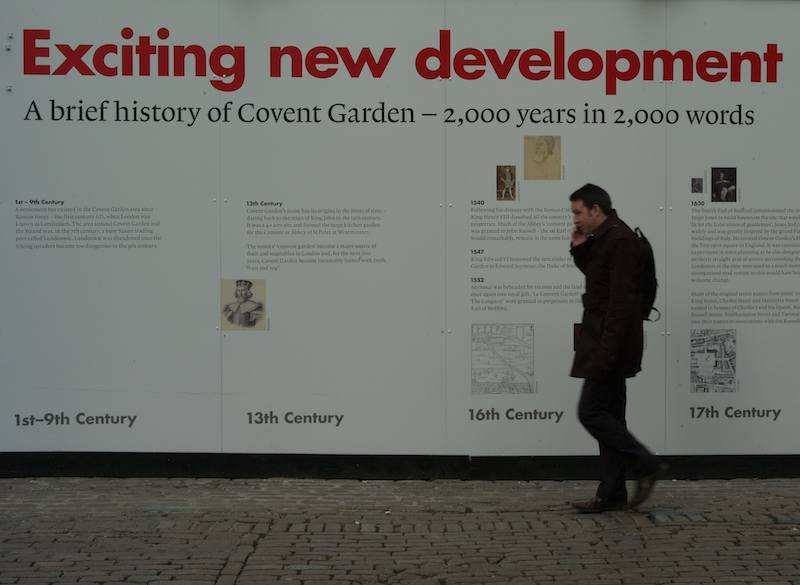Covent Garden, London, yesterday. Flickr version here.
Here comes the Sun
Apropos my musings about the evocative power of the Beatles’ Here Comes the Sun, this wonderful little chap emerged just before dawn on Saturday morning, yelling loudly to make sure that everyone knew he’d arrived. The funny thing was that we had been told by the ultrasound folks to expect a girl.
He’s my first grandchild, and his arrival has been the most wonderful, moving experience. Everything people say about it is true. He also seems to me to be extraordinarily handsome. Note the rakish angle at which he wears his hat. And the way he is already fashionably bored by all the fuss going on around him.
The Wall: 20 Years Later
This is wonderful — a NYT photo-feature to mark the anniversary of the fall of the Berlin Wall. It’s a set of photographs of the same locations taken in 2009 and 1989. You can wipe from one to the other. The one I like best is the view of the Reichstag, but theyt’re all terrific. Sobering and moving too.
Consumer ‘rights’ in a digital world
This morning’s Observer column.
You go to Waterstone’s, buy a copy of Orwell’s 1984 and take it home. Two days later you get up and find that agents of Waterstone's have entered the house during the night and removed the offending volume. They’ve left a terse note explaining what they’ve done and enclosing a credit note for the cost of the book. Enraged, you phone the manager of Waterstone's, who explains that everything is in accordance with the service agreement you accepted when you bought the book.
You don’t have to be a lawyer to know that this would not be tolerated in the real world of physical objects.Yet it's commonplace – indeed universal – in the world of information goods. And what makes it possible is the ‘End User Licence Agreement’ (EULA) that most of us click to accept when we first use hardware, software or online services.
The Kindle EULA is a good example…
Digger delays his charge
Well, well. It seems that the Digger has run into some difficulties.
Rupert Murdoch admitted last night that his plans for News Corp newspapers to begin charging online by June next year, might have to be postponed.
To date the media mogul has been the most proactive publisher in the move to charge for online news, consistently repeating the mantra that: “Quality journalism is not cheap and an industry that gives away its content is simply cannibalizing its ability to produce good reporting.”
Tsk, tsk. Poor project management.
Sunlight memories
Just listening to Jerry Springer on Desert Island Discs One of his choices is Here Comes the Sun by the Beatles. He chose it because it was played as his wife came down the aisle at their wedding. As the track plays I am suddenly transported back to the moment, forty years ago, when I first heard the song. It was a glorious, crisp Autumn morning at the beginning of my second year in Cambridge. The sun was flooding in through the bay window of the College flat that Carol and I and our first child then shared. I had just finished constructing a crude DIY Hi-Fi system. A few days earlier we had purchased the album, but hadn’t been able to listen to it. So I put it on the turntable and, with bated breath, switched on the amp. And there it was. I thought it was such a beautiful, optimistic, moving song.
It still is. In a few days, my first grandchild will be born. And when she arrives I will play it then too. Strange how music reaches the places that other media cannot reach.
What you read is what you get
No comment
Spotted in a leafy Cambridge road this morning. Imagine what you’d get if you Googled them.
LATER: I just did that (i.e. a Google search for “erection specialists Cambridge”) and found that other photographers have spotted them too — for example here and here. But at least the ‘sponsored links’ were exactly what you’d expect.
The fearful commentariat
Nice piece by Shane Richmond in the Telegraph about how fear and loathing of Twitter is leading newspaper columnists to make utter fools of themselves.
It’s now possible for columnists and companies to hear what people are saying about them. That’s unnerving for columnists, not least because their opinions are now frequently challenged by people who know more than they do. Instead of responding like adults – correcting when they’ve made a mistake, engaging when someone raises a sensible point and defending themselves from false accusations – they are whining like children and dismissing technologies that they don’t understand.
It’s not the complaints culture on Twitter that annoys me, it’s the complaints culture among columnists that is getting tiresome.
Amen. Worth reading in full.
Perfect timing
Emma Freud told an interesting story on the radio this morning about her father, Clement. He had, she said, “a perfect death”. On the day in question, he’d been to the races (at Exeter), had won on the horses, had a good lunch with his “second best friend” (apparently he was punctilious about ranking his friendships), and was writing his column (about the Exeter meeting) for a racing newspaper when he dropped dead in mid-sentence. The next day, Emma and her Mum woke up his computer and found that the last words he’d written were “In God’s good time…”.




